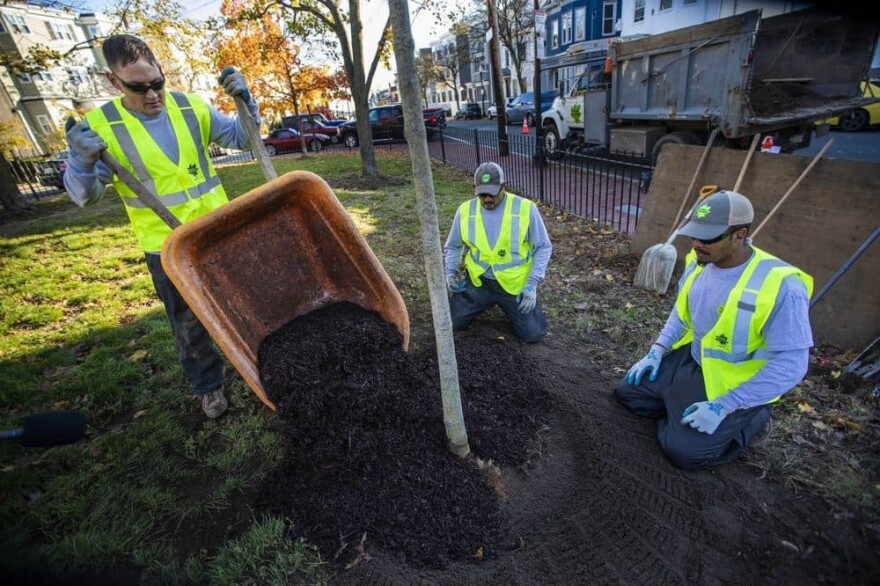Trees are home to all sorts of critters: birds, squirrels, frogs and more than a trillion teeny tiny microbes living in roots, bark and leaves.
These fungi, bacteria and microorganisms play an important role in tree health; Beneficial microbes can help a tree take up nutrients or defend itself against disease.
But a new study in Nature Cities published Friday found that oak trees in Boston have a greater number of “bad” microbes, like pathogens and plant decomposers, than beneficial ones because of city stressors like heat and pollution. This disruption of the tree microbiome could spell trouble for the health of both trees and humans, according to the study‘s authors.
“Trees are really, really important to our whole planet, and especially in cities,” said Kathryn Atherton, the study’s lead author and a former Boston University Ph.D. student in the Urban Biogeoscience and Environmental Health program. “If we’re going to be planting trees, we really need to understand how we can best take care of tree health.”
Trees have many benefits for ecosystem and human health. They provide shady relief on hot city sidewalks and lower surrounding air temperature through evaporation. People who live near trees show signs of improved physical and mental health. They can also beautify a neighborhood, soak up rainwater runoff and slow climate change.
But while trees in Boston grow four times as fast as their rural brethren, they also die twice as quickly, according to previous research. By understanding what’s different about urban tree microbiomes, Atherton hopes to find ways to help Boston’s tree canopy thrive.
“ I’m really hoping that this study helps us to think more about how we can improve the health of trees,” Atherton said.
City officials have directed millions of dollars toward tree planting initiatives. In 2023, Boston received an $11.4 million federal grant to improve tree care. And this year, state officials announced a plan to spend nearly $1.4 million to plant trees in more than a dozen communities across the commonwealth.
“ Trees provide so much benefit to humans and to cities and to our planet,” Atherton said.
A microbial metropolis
In the study, researchers analyzed DNA samples from the soil, leaves and roots of nearly 100 oak trees across the state, from rural Petersham to urban Boston. Atherton chose oak trees because they’re both native to the state and commonly planted in Boston. Plus, previous studies suggest fungi that typically grow on these trees are more susceptible to city stressors.

When the researchers compared urban trees to rural ones, they found that city life distorts the tree microbiome in many ways.
One key difference was in “ectomycorrhizal fungi,” which grow on tree roots. These underground microbes protect the tree from disease and help it pull in nutrients from the soil.
Researchers found that street trees have less ectomycorrhizal fungi than rural trees. Instead, researchers found more decomposers that break down plant material, as well as more insect and human pathogens.
“Living in the city … is basically a nightmare situation for a tree,” said Jennifer Bhatnagar, associate biology professor at Boston University and the paper’s senior author. She said the microbiomes of city trees have shifted in a way “that is not beneficial for the tree, necessarily.”
That shift may not be good for humans, either. Researchers observed animal and human pathogens associated with high levels of air pollution on urban trees. They also found bacteria that produce greenhouse gases like nitrous oxide, potentially limiting the ability of trees to absorb carbon dioxide from the atmosphere. City trees also have fewer microbes that eat methane, another potent greenhouse gas.
“The health of the tree microbiome also impacts human health and the health of our entire ecosystem,” Atherton said.
Treating urban trees right
The study raises questions about how to improve tree care in Boston and other cities, especially as many officials increase tree-planting efforts, Atherton said. Boston has planted 1,300 trees so far this year, according to data from the city’s Parks and Recreation Department.

Todd Mistor, Boston’s director of the Urban Forestry Division who wasn’t involved in the study, said the division is always thinking about how to improve growing conditions for the more than 40,000 trees they manage.
The division began adding a fungi to the roots of newly-planted trees that could help with better absorption of water and nutrients, Mistor said.
Still, the department is in the early stages of its Urban Forest Plan and the benefits that trees provide only grow with each year they live, he added. The department just finished a year of intensive data collection to better understand how effective their efforts have been since 2019.
“ We really have to get those trees to survive and thrive,” Mistor said. “They’re living organisms and they take time to truly manifest the benefits that we want to see.”
Lilian Bonilla-Reyes, an urban forestry fellow at the nonprofit Speak for the Trees who wasn’t involved in the study, said it’s not surprising that city trees’ microbiomes are different from rural trees.
“ Urban trees have to deal with a lot of different factors that put them at risk,” she said, ticking off tree stressors like pedestrian traffic, stormwater runoff and dog poop.

Bonilla-Reyes lives in East Boston where she said air pollution from Logan Airport has affected her own quality of life, so she said it’s fair to assume it has also affected trees in her neighborhood.
“It’s definitely alarming when you think about it,” she said.
This article was originally published on WBUR.org.
Copyright 2025 WBUR

